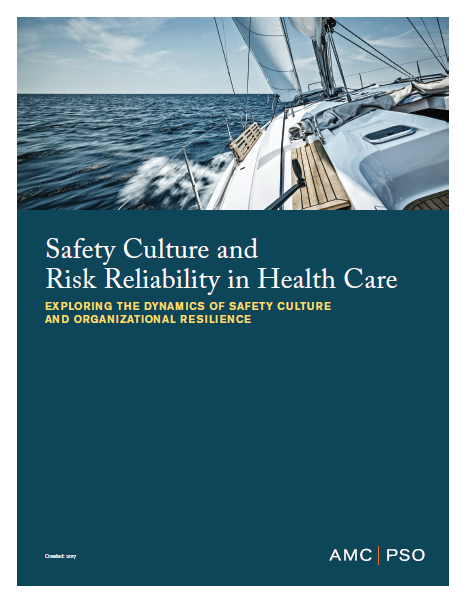Article
Safety Culture and Risk Reliability in Health Care


The Academic Medical Center Patient Safety Organization hosted a two-day culture of safety and organizational risk reliability symposium in December 2016, led by notable safety and risk reliability expert Paul LeSage of SG-Collaborative Solutions. Invited attendees included risk managers, patient safety and quality leaders, front line managers, human resources staff, and representatives of senior leadership from AMC PSO member organizations. Key concepts and takeaways are highlighted in this publication.
Background
Since the advent of the 2000 Institute of Medicine report, To Err is Human, the healthcare community has made significant efforts to shift the paradigm of seeing medical error as a reason for blame, to an opportunity for learning and improvement. From physician offices to large academic medical centers, advances are being made to develop organizational structures and processes that support a “Culture of Safety,” or as known in other industries, a “Safety Culture.”
Although both terms are frequently used, they lack a single, concrete definition, and are often described as a set of principles and characteristics. In the guide Managing Maintenance Error: A Practical Guide, noted human error experts James Reason, PhD, and Alan Hobbs, PhD, define a culture of safety as one that provides highly reliable and safe care, relying on three overarching principles: trust, reporting, and improvement. The Agency for Healthcare Research and Quality (AHRQ) establishes that a culture of safety has these key features:
- acknowledgment of the high-risk nature of an organization's activities and the determination to achieve consistently safe operations
- a blame-free environment where individuals are able to report errors and near misses without fear of reprimand or punishment
- encouragement of collaboration across ranks and disciplines to seek solutions to patient safety problems
- organizational commitment of resources to address safety concerns
A key element of a safety culture is the concept of having a “Just Culture,” a values-supportive model of shared accountability first introduced by David Marx, JD, noted author on organizational management and reliability. In a Just Culture, the goal is to strike the right balance in establishing a blame-free environment that acknowledges our human fallibilities and the role that system deficiencies play in contributing to human error and creating competing priorities. This, coupled with acceptance of personal accountability for individual behavioral choices, helps create a “just” healthcare system that supports rather than stifles safety and the caregivers who make up that system.
Fill out the form to get the entire printable whitepaper.
Related Articles
Accelerating Patient Safety Improvement


CRICO Operating Room Team Training Collaborative: An Approach to Speaking Up

CRICO OR Team Training Program with Simulation

Are Attendings Liable for Residents’ Negligence?
Is the attending physician for an inpatient legally responsible for all the care provided by the clinical team while a patient is in the hospital? The short answer to this question is: No.
